How do the words oil and art connect?
When we think of oil in reference to the art world, we may tend to think of large corporations sponsoring costly exhibitions, and art institutions, for the sake of being able to showcase art, glossing over the notion of nature being disrupted to find its black gold. Due to oil being a controversial resource, it does not for many, make for good company with art. This last year, activists dressed up as ancient Greek warriors displayed a large Trojan horse within the grounds of the British Museum to protest the sponsorship deal with BP. Furthermore, at the National Gallery, protestors from Extinction Rebellion appeared semi-naked immersed in fake oil in objection to the Portrait Award being linked to the oil company.
Googling the pros and cons of oil, provides us with an extensive list to decide on which side we would like to sit on in regards to the substance. It is important knowledge for us to know about, so that we can tend to our world and think about what we are cultivating in it, looking at both the economy of countries and livelihood of people, and the effects and impact on the environment. Though we may have an idea of what oil has meant to certain nations, to politics and how it may fuel power, and though we do think of how this substance has affected the environment and nature’s essence, rarely is there mention of those who have grown up around oil. As citizens, workers, children, what must that be like? And what would their relationship with oil throughout history be perceived as?
A new exhibition, entitled Fire of Love by artist Amin Roshan is currently on show at Rossi Rossi Gallery in London in collaboration with Janet Rady Fine Art and curated by Janet Rady. It displays an array of the artist’s work that initially stem from that very essence of growing up around oil.
“The smell of oil streams, childhood games with tar, walking over pipelines on the way to school…, all are still alive for me. Today I draw from these childhood images and memories to paint on canvas using crude oil." -Amin Roshan
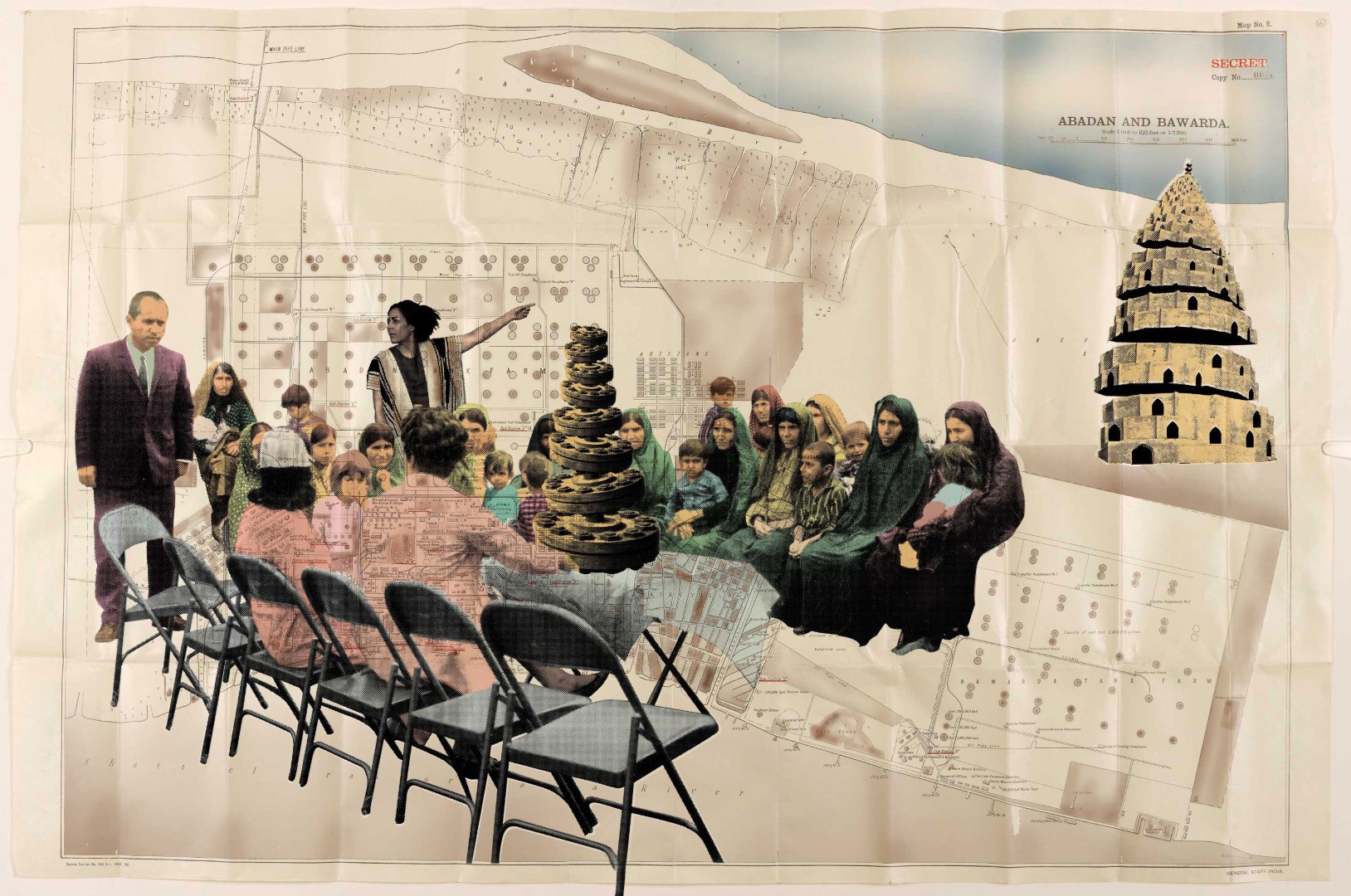
Babel Towers by Amin Roshan. 2019. Watercolour crude oil silk screen on paper map. Edition of 5. 45.8 x 76cm
Amin Roshan was born where the first oil well in the Middle East was discovered: in the Naftoon district of Masjid-i-Sulamain, the Khuzestan Province of southwestern Iran. His family come from the Bahktiari tribe and have for many generations been involved in the country’s oil industry. Toxic gas release made the family and young Amin aged 6, leave the district for Ahwaz, only going back to the oil district for the summers to play with his cousins. The artist’s childhood impacted his personal journey, for despite the long family tradition of working amongst the oil fields, Roshan decided to study graphic design and pursue art. This resulted in a clever and intriguing amalgamation within the artist’s work. Combining metaphorically and literally oil and art, through the spheres of history, geopolitics and civil society. Without posing any judgement on the subject matter, the artist expresses that “It is not easy to say why I have chosen oil as a theme...The main reason may be its excessive impact and influence not only on my life and family but also on the geography of Iran”.
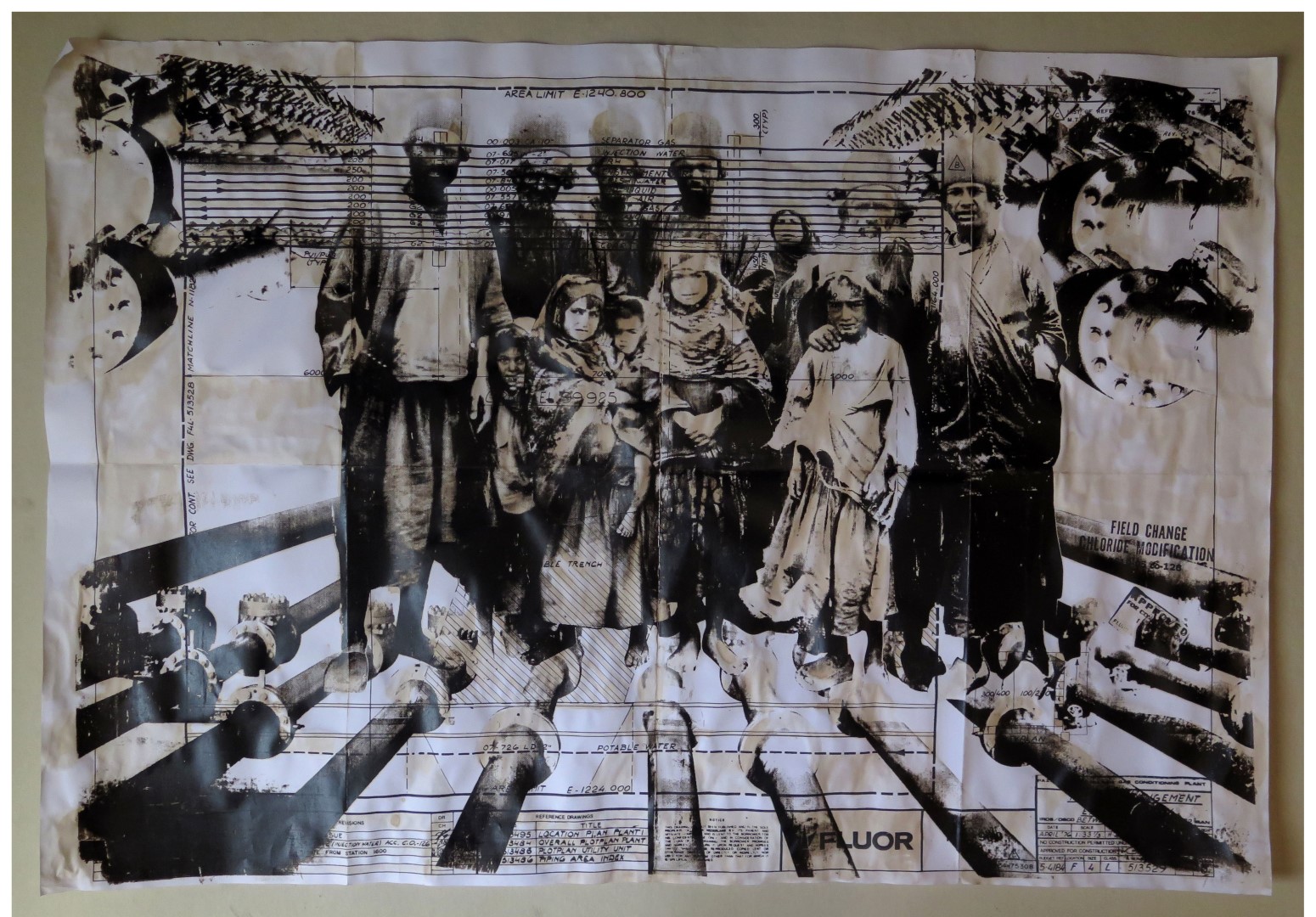
Ancestors by Amin Roshan. 2013. Tea crude oil silk screen on paper map. Editions 2-5. 61 x 89cm.
"These maps partly relate to the National Iranian Oil Company, British documents, and partly to those of the Anglo-Iranian Oil Company. They show the cities of Abadan and Ahwaz at the time of the Second World War, which at the time were the most important cities of Iran and the region. When these maps were created they were confidential. [...] I want to provide a window into the lives of the people who were producing these plans. Their lives were characterised by continuous gatherings, with endless servings of tea - tea was a constant feature in their lives - all the while thinking about oil and oil plans in form or another. [...] I have used (for this picture) brewed tea and have applied crude oil with the silk screen technique. When Iranians discovered oil, we became modern welfare increased and these plans and maps had a great impact on our lives. [...] But oil also has a darker side to it, engendering plots to overthrow the country, external and internal tribal wars and deaths and many other matters which all come back to one point."
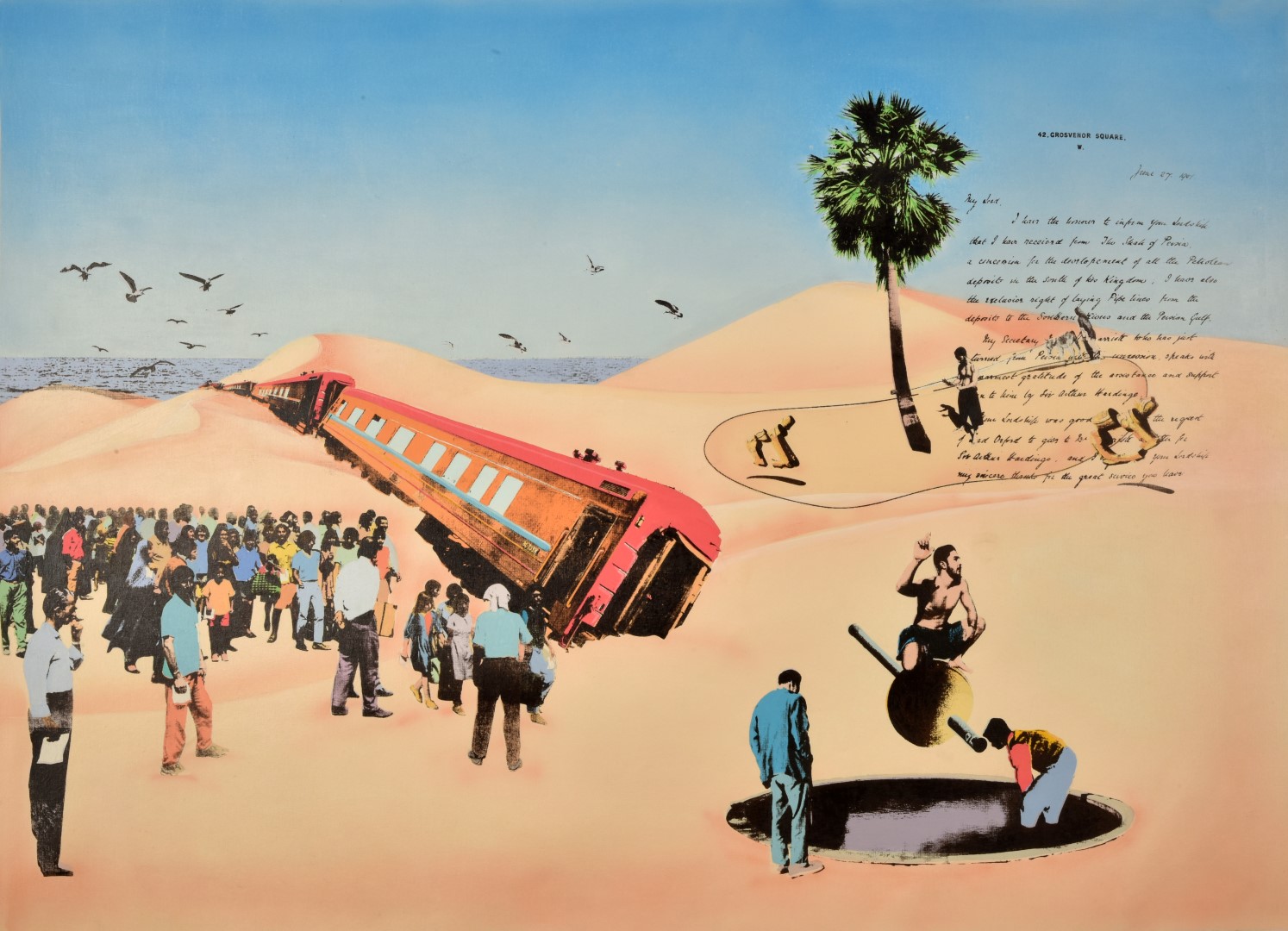
Wandering by Amin Roshan. 2019. Acrylic crude oil silk screen on canvas. Edition of 3. 80 x 110cm
Roshan’s exhibition, Fire of Love, brings together mostly a set of grand silk screen artworks. The themes of history, economy and politics, are brought forth through a visual delight and arrangement of colour, magnetism and references from archival material, showcasing the role that was played by the British alongside the Iranians to establish the oil industry. British produced historical maps are screen printed on, as vintage photographs of key players and scenes from the Iran-Iraq war all take shape and place into composition in Roshan’s artworks, with the canvases finished off with crude oil that was acquired either from a valley located in Masjid-i-Sulaiman or from relatives working for the National Oil Company. This act ties in with his subject matter, either to preserve a memory, or to literally bring forth earth’s black gold onto canvas showcasing how its perceived value can find its value in art, or perhaps as a metaphor to his childhood experience, as the artist references that he used “to wipe of the stain of oil from his shoes, after playing and jumping in river, with difficulty -crude oil is very difficult to clean.”
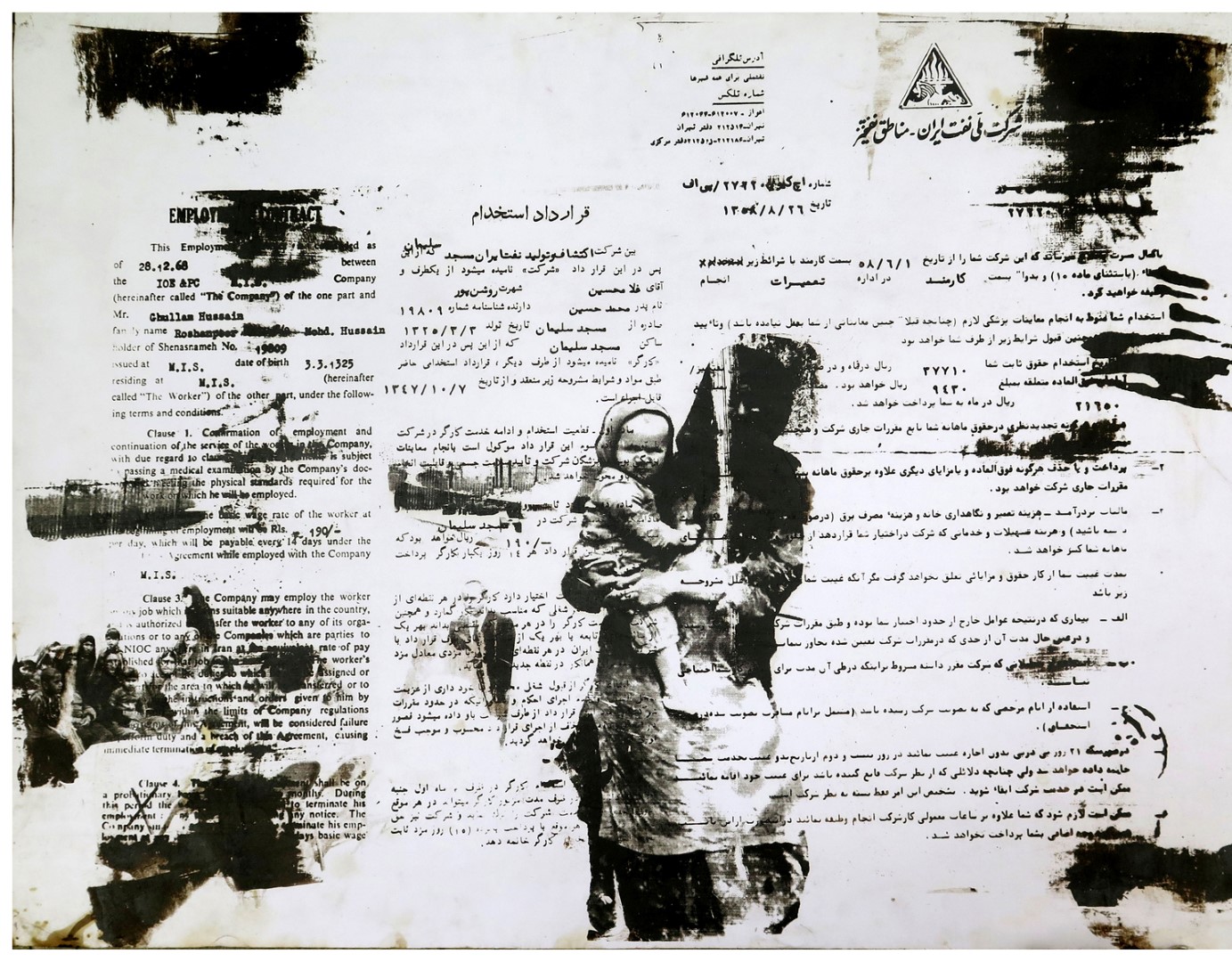
Fathers Contract by Amin Roshan. 2013. Crude oil silk screen on paper. Edition of 5. 68.5 x 86cm.
.jpg)
To Follow Reza Shah by Amin Roshan. 2013. Acrylic silk screen with crude oil. 170 x 140 cm.
Also on display in the exhibition, are a standard helmet or safety hat and re-purposed torch engraved and inked. Elevating found objects and the everyday into a creative arena, putting forth that the workforce and work objects behind the value of oil, have also great value. The safety hat, is layered in political meaning, as the artist explains: "I utilised the same safety hats worn today by the National Iranian Oil Company's workers, hats which are strongly connected to nationalisation [...] . These hats were produced in Great Britain and on the inside of some of these hats we can see markings or remnants related to those workers who wore the hats in days gone by. "
The engraved blowtorch artwork, features a lion and a bull, for "In eastern culture, the bull symbolises the moon and the lion is a symbol of the sun. Just as the lion overcomes the bull, so it follows that the sun prevails over the moon, the day over night and light over darkness." In this work, Amin Roshan has reversed the story, with the bull overcoming the lion, suggesting that darkness could overcome light-perhaps in an allegory to oil-and inspired by the poetry of Rumi that reads: "There is no rising dust on the road, what has happened to the riders? They have died in fear, where are the great men?"
All the works that form Fire of Love, embody the layers of thought and perspectives the artist has grown up with. By referring to oil as fire, Roshan is also referencing the role of oil in ancient rituals of his region, embodying what is rooted in Iranian literature, the similarities between oil and fire, referencing once more the poet Rumi that evoked: "Until you escape the fire, you are sour and raw like cheese. Thousands of sweethearts are not profitable."
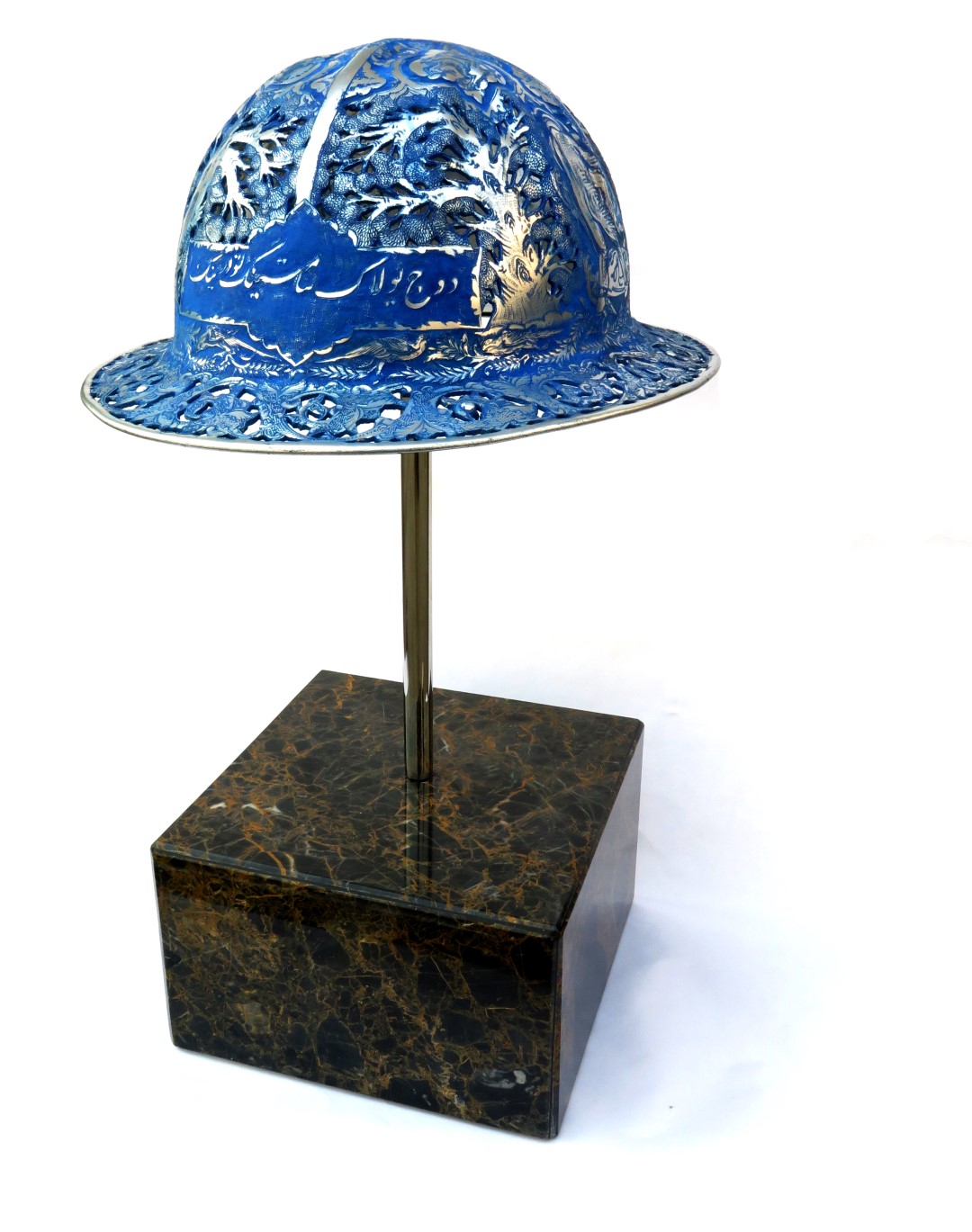
.png)
Jikaks Crown by Amin Roshan. 2019. Engraving on original workers helmet from the Iranian Oil Company. Unique work. 49 x 27 x 31cm.
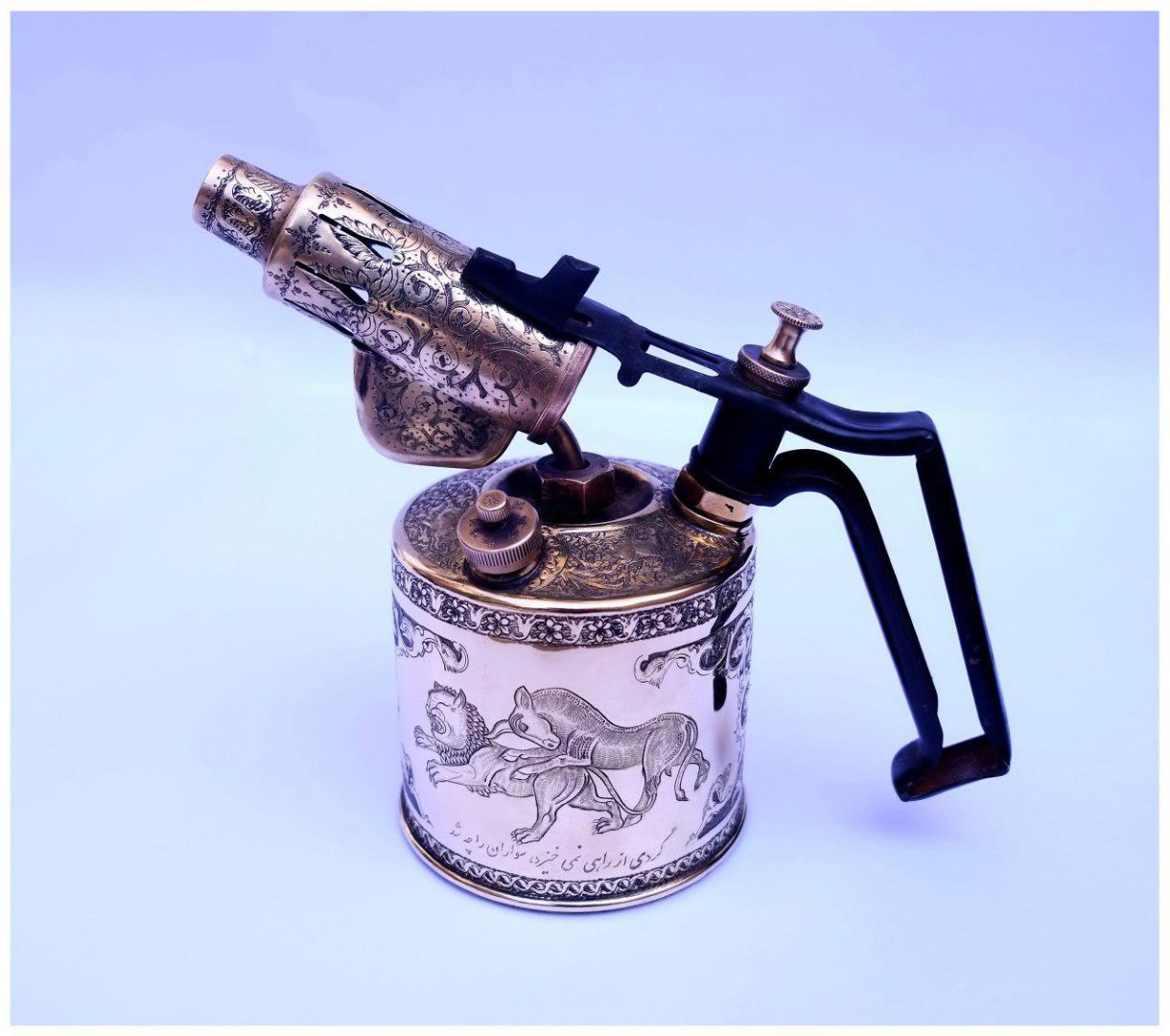
Lion and the Bull by Amin Roshan. 2014. Blowtorch brass. Unique work. 21.5 x 12 x 25cm.
Though art may offer to some, a form of escapism, it is nevertheless difficult to escape certain aspects. There are many conversations regarding politics and history that are difficult to have, but are needed, and as the world moves forward, humanity is thankfully opening up to new sustainable ways. Art can seep in and aid in the understanding of certain issues, look at historical perspectives and question notions and ideas, as well as pave the way for matters to be brought into the light.
The artworks in the Fire of Love exhibition are visually enticing and embedded in geopolitical narration, furthermore, the artist is looking within and sharing with his audience his experiences and his family’s heritage.
For a long time, oil was the most valuable resource, with technology embedded in our lives, and people uniting across continents for a cleaner climate, it is now not as important as it used to be, and at any time it may stop fuelling power. Art or creativity probably won’t stop, it may evolve (through technology) but it won’t stop. Creation will always be needed, especially when we are often bound to being fed one perspective on matters that affect us, either politically or economically. Through technological channels, exhibitions and art in public spaces, art can offer other perspectives.
Art enabled Amin Roshan to branch out from his family’s tradition of working in oil and share his emotions of his own journey, question notions and even maybe find some answers to the questions he had, all whilst engaging into a historical visual conversation with his audience. It’s significant to see the impact oil has on people who were and are affected by it first hand. On display at Rossi and Rossi in London, the alluring and compelling artworks by Amin Roshan curated by Janet Rady, show how politics may infiltrate artistic thoughts, and how art can infiltrate our thoughts and perceptions on subjects. Perhaps if we understand the past, we may be able to seek a better future, whether that be in politics, in relations or in regards to the environment. The art by Amin Roshan is engaging, impactful and layered between being aesthetically enticing and historically charged, showcasing the paradox of history and politics, but also of art.
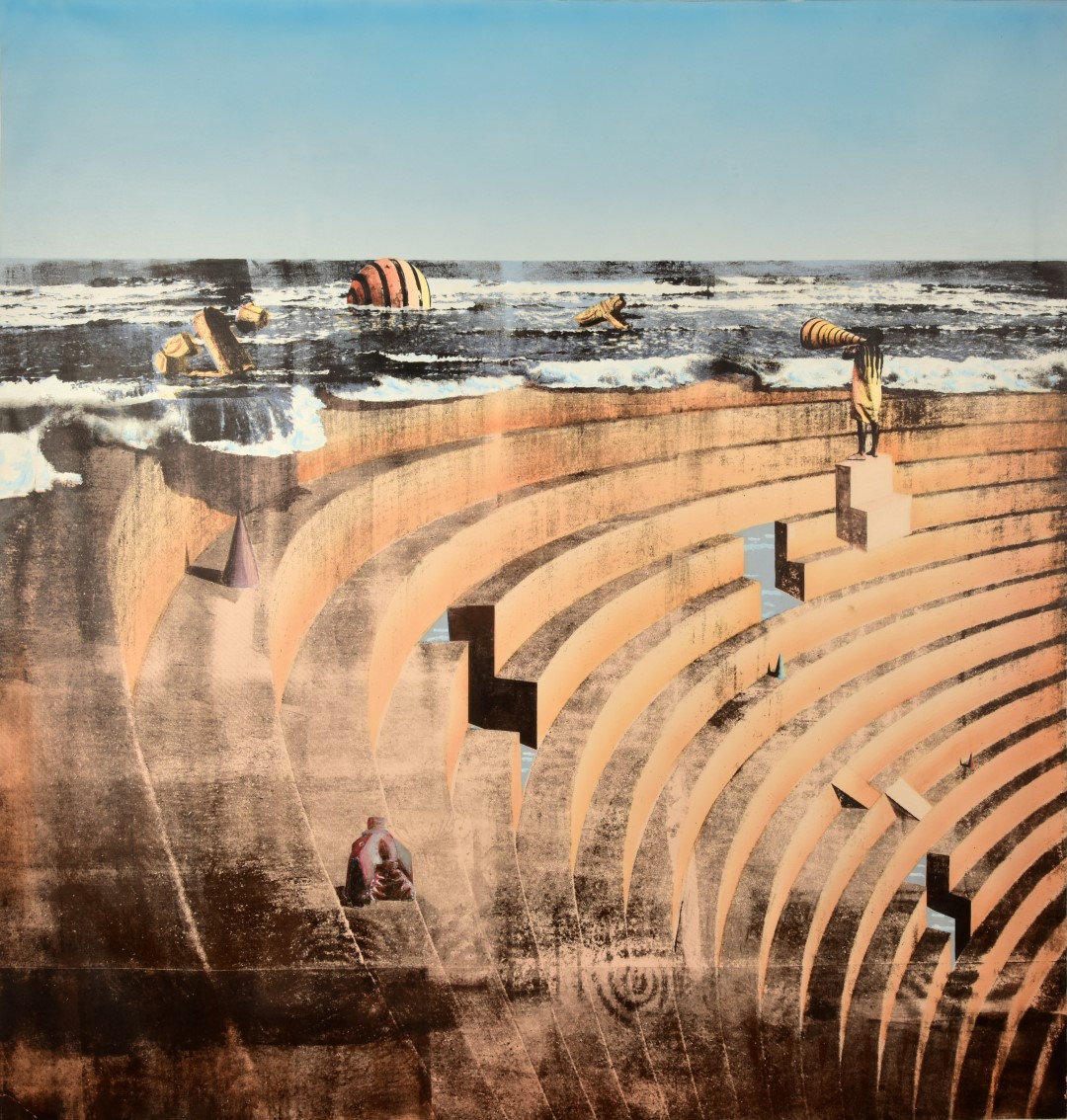
Mythology Staircase by Amin Roshan. 2019. Acrylic crude oil silk screen on canvas. Edition of 3. 140 x 140cm.
.jpg)
Woman with Cylinder by Amin Roshan. 2019. Acrylic crude oil silk screen on canvas. Edition of 3. 120 x 90cm (Large).
Amin Roshan was born in 1982 in Masjid-i-Sulaiman where the Middle East’s first oil well was discovered. As a young child Amin and his family moved to the nearby city of Ahwaz and here he grew up. Amin’s grandfather, father and brother are retired or current employees of the National Iranian Oil Company (NIOC) and Amin’s work focuses on capturing the relationship of culture which emerged from the discovery of oil and its experience with modern and contemporary Iran. Amin’s life experience in a traditional and industrial environment has deeply influenced his body of work, one can detect a variety of issues and the use of different media: such as the gas cylinder’s performance, the Iranian bagpipe, engravings applied on safety hats used by NIOC workers and silk screen printing with crude oil. Amin Roshan took a Diploma in Graphic Design from the School of Visual Arts in Ahwaz in 1999 and thereafter worked for several years as a professional cartoonist with many newspapers. He has participated in exhibitions at prestigious international festivals, namely Satyrykon (Poland), cearquefou (France), Portugal, Women Deliver (USA), Taijon (South Korea) and Aydin Dogan (Turkey). He graduated from the Islamic Revolution Technical College in 2001
ROSSI & ROSSI:
Founded in 1985 in London by Anna Maria Rossi, who was later joined by her son, Fabio, Rossi & Rossi is today a leading representative of contemporary artists from the Asia-Pacific region. The gallery operates from its headquarters in Hong Kong’s South Island Cultural District, as well as a nearby showroom, and offices in St. James’s, London. A pioneer in the development of contemporary Asian art, Rossi & Rossi attracts major museums and private collectors worldwide.
In 2017, the gallery embarked on a series of exhibitions in Asia dedicated to bringing greater attention to modern and contemporary European artists. The following year, it staged the first exhibition in the region on the work of the late Italian avant-garde artist Aldo Mondino, in addition to a successful commercial presentation of works by Italian painter and printmaker Giorgio Morandi. Rossi & Rossi has also recently presented shows with Massimo Antonaci and Bertozzi & Casoni, and exhibited seminal Italian post-war artists Lucio Fontana, Enrico Castellani, Piero Manzoni, Alighiero Boetti and Carol Rama, both in the Hong Kong showroom and abroad at the Shanghai West Bund art fair.
Rossi & Rossi is a member of the Society of London Art Dealers (SLAD), Asian Art in London (AAL), the Hong Kong Art Gallery Association (HKAGA) and the South Island Cultural District (SICD). The gallery also participates in pre-eminent regional and international art fairs, including Art Basel Hong Kong, West Bund Shanghai and TEFAF Maastricht.
JANET RADY
Based between London and the United Arab Emirates, Gallery Director and Curator, Janet Rady is a specialist in Contemporary Art from the Middle East, with thirty years’ experience of the international art market including leading auction houses and major commercial galleries. Born in Malta, Janet first visited the Middle East in 1974 when she went to Iran and subsequently she lived there for a year from 1983-84. She now travels regularly to the region.
Janet Rady holds a Masters Degree in Islamic Art History from the University of Melbourne and a BA from the School of Oriental and African Studies, University of London. She is a member of the Arab British Chamber of Commerce and sits on the Advisory Council of CARAVAN. Janet sits on the Council of the Iran Society, on the Editorial Board of the Middle East in London magazine, and is a nominator for the V&A Jameel Prize, curator for the Benetton Foundation Imago Mundi Project and a Judge for the BEHNAM BAKHTIAR AWARD.
Janet has guest curated exhibitions for the peacebuilding NGO CARAVAN Arts including the I AM touring exhibition of 31 women artists from the Middle East and an exhibition of 38 Premier Bahraini, Egyptian and Lebanese artists entitled “KHALIL GIBRAN: A Guide for our Times” at Sotheby’s London. She has also edited the book “33 Artists... 33 Islands... A Kingdom of Art” - a comprehensive survey of the artists of Bahrain
.jpg)
Women with Pots on Head by Amin Roshan. 2019. Watercolour, crude oil, silk screen on paper. 59.5 x 83.5 cm.
Fire of Love at Rossi Rossi London Presented by Janet Rady Fine Art, on until 27th March 2020.
21 Georgian House, 10 Bury Street, London SW1Y 6AA
+44 20 7629 6888| BY APPOINTMENT
